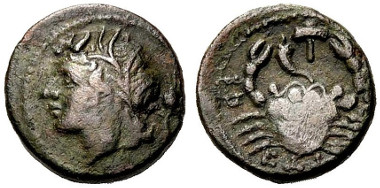By Claire Franklin
The belief systems of the ancient world teemed with beings who were a mixture of human, animal and divine elements. Many of these are so familiar to us that we no longer wonder when we see depictions of men with wings, goats’ hooves or horns, or part-human, part-animal monsters. Yet some images from the ancient world are so curious that they demand further investigation. The small bronze ‘quarters’ (or trihemiobols) minted by the Brettii of South Italy at around the time of the Punic War are just one such example.
Bruttium, Bretti. Quarter, bronze, 208-205 B.C. Head with crab-helmet to l. Rv. BRET-TION Crab; above Bucranium or torch as secondary symbol. 2,04 g. Scheu, Bronze,51. SNG Munich 1343.
The obverse of this 2,04 g. coin depicts the head of someone wearing a helmet. Upon closer inspection this helmet turns out to be an inverted crab, with the front claw discreetly forming a form of cheek-guard. One wonders what the French surrealists would have made of the somewhat unsettling image. Who was this figure? Many scholars have puzzled over this question.
Like the majority of ancient coins (the exceptions are few and far between), the only legend is that naming the people responsible for the coin, BRETTION, the Brettii (also known as Brettians, Bruttii or Bruttians). The crab-wearer is generally described as female (being beardless; although Apollo, Mars and various river gods are also depicted without beards on many ancient coins), and ‘she’ is often interpreted as a sea-goddess, due to the presence of the crab.
Unfortunately no ancient written sources known to me refer to a god or goddess (or anyone, for that matter) with a crab-shell helmet. The image is however not infrequently found in ancient art. A mosaic in Tagliura in Libya shows just such a goddess in the Villa dell gara della Nereidi (LIMC I,2,Tf. 577, 7-8), and another rescued from the site of Zeugma, now in the Gaziantep Museum in Turkey, represents a male god, presumably Poseidon, with crabs’ claws on his head. There is even such a god on a mosaic in Verulamium, modern St. Albans, in England. The iconography is logical when we consider that Demeter wears a wreath of corn ears, the Roman goddess Pomona a wreath of fruits, and river gods on coins are sometimes depicted with a coronet of reeds: it suggests the deity’s connection with, and dominance over the sea.
But is she a particular sea-goddess? She could be Thetis, the Nereid (daughter of Nereus) and beloved of Peleus, who bore the famous Homeric hero Achilles. Pindar and others describe how Thetis took on many animal and natural forms in an attempt to outwit the over-zealous Peleus- “now a dragon, now a lion, fire and water” (leon drakon te, pur hudor, Frag. 154). The scholiast on Apollonius Rhodius remarks that she even turned herself into a squid (sepia, I,582). This pantomorphe or many-formed goddess could be a candidate for the crab-hatted lady, and other coins of the Brettii have more conventional portraits which are interpreted as being Thetis. The most common interpretation, however, is that the head represents Amphitrite, another member of the underwater pantheon of ancient times. Amphitrite is frequently mentioned in ancient texts alongside her male ‘colleagues’ Poseidon, Nereus, Glaukos, Palaimon and Proteus: in the Odyssey of Homer she is described as feeding and caring for the monsters of the sea, and she is almost synonymous with the ocean (Od. 3,91, 12.60). For Hesiod she is the mother of the sea-god Triton, and Pindar describes her as Poseidon’s wife: she is altogether an important goddess, but since the role and iconography of ancient water gods is – excuse the pun – fairly fluid, she shares attributes with many others.
A second coin of the Brettii, (Scheu, Bronze Coins of the Brettii, No. 33), also ca. 208-205 B.C. where the (male?) Deity wears a crown of reeds.
We do not know for sure if Thetis or Amphitrite held a special meaning for the Brettii. The sea and the deities associated with it played an important role in much of Southern Italy at this time. The historical background to this coin issue is also somewhat obscure. Its exact chronology has been much disputed, but it was a restoration of a previous, similar-looking issue which was minted at around the time of Rome’s ‘Punic’ wars with Carthage, and was probably minted around 208-205 B.C. The southern Italian states were caught up in the long series of conflicts, and they were frequently forced to change sides. It may be significant that the goddess bears a certain resemblance to the head of the goddess Roma on the Roman coins which were also being minted in Southern Italy in the same period, as the Romans were in constant need of money to pay the local mercenaries who were fighting on their behalf. It is possible that these coins were produced for Bruttians fighting for Rome. However, the Brettii were not loyal allies of Rome, and they defected to the Carthaginian side in the course of the Second Punic War in 216 B.C., following the brilliant Carthaginian general Hannibal’s victory over the Romans at Cannae.
Was the crab goddess their own, local answer to the helmeted Roma? We cannot know for sure, but at this stage the Bruttians’ days were numbered. The Koinon or alliance of Bruttian tribes was finally destroyed in 203 B.C., and they were to mint no more coins.
These coins will be for sale in Münzen & Medaillen GmbH Auction 41, which takes place in Stuttgart on 11th December 2014.







